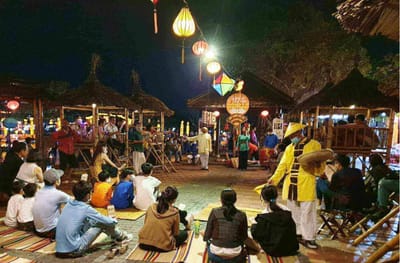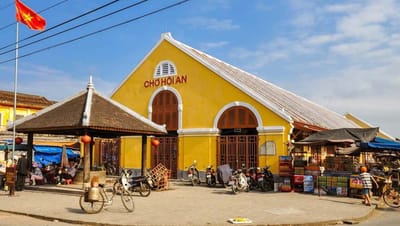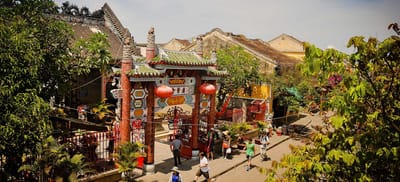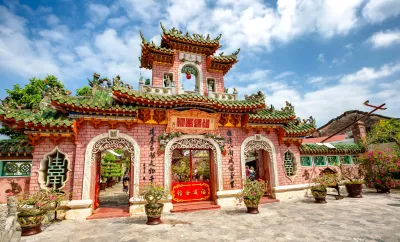Inside Hoi An Night Market: Food, Shopping & Local Crafts

Executive Summary
Market Essentials: The Nguyen Hoang Night Market operates nightly 5:00–11:00 PM (peak activity 7:00–9:00 PM) on An Hoi Island, accessed via the pedestrian An Hoi Bridge from Bach Dang Street. Spanning approximately 300 meters with 50+ vendors, the market offers handmade silk lanterns, embroidered textiles, wooden carvings, paintings, jewelry, and Vietnamese street food including cao lầu, bánh xèo, grilled skewers, and tropical smoothies. Unlike high-pressure markets elsewhere in Vietnam, Hoi An's night market maintains friendly bargaining culture—initial prices run 30–50% above final negotiated rates. Cash-only environment (no cards accepted); bring small VND denominations. Free entry with no tickets required. Atmosphere blends commercial energy with cultural authenticity, making it Hoi An's primary evening shopping destination for families, couples, and souvenir hunters.
The Hoi An Night Market serves as the ancient town's commercial heart after sunset—a pedestrian marketplace where local crafts, Vietnamese cuisine, and evening entertainment converge into a sensory experience distinct from sterile shopping malls or aggressive tourist markets. Understanding the market's layout, vendor offerings, and cultural dynamics transforms a simple shopping trip into authentic engagement with Hoi An's contemporary commercial life.
Location & Access
Finding the Night Market
The Nguyen Hoang Night Market occupies An Hoi Island, a small island in the Thu Bon River directly opposite the ancient town's riverfront. The pedestrian An Hoi Bridge (also called Cau An Hoi) serves as the primary access point, connecting Bach Dang Street to the island's market area.
Starting from Central Landmarks:
From Japanese Covered Bridge:
Walk west along Tran Phu Street toward the river (500 meters, 6–8 minutes). Turn left onto Bach Dang Street and follow the riverfront east to An Hoi Bridge (200 meters, 3 minutes). Cross the bridge (elevated pedestrian walkway) directly into market entrance.
From Central Market:
Exit toward the river, turn right onto Bach Dang Street, walk east along the riverfront (400 meters, 5 minutes) to An Hoi Bridge. Market entrance immediately after crossing.
The bridge itself provides excellent photo opportunities—pause mid-crossing for panoramic views of the ancient town's lantern-lit waterfront, sampan boats below, and the market's colorful stalls ahead.
Market Layout
An Hoi Island's market area extends approximately 300 meters along Nguyen Phuc Chu Street, with perpendicular side lanes creating a loose grid pattern. Stall categories cluster organically rather than following strict zoning:
Eastern Section (Near An Hoi Bridge):
Handicrafts, lanterns, textiles, and souvenir stalls dominate. This area sees heaviest foot traffic as visitors enter from the bridge.
Central Section:
Mixed vendors—food stalls interspersed with handicrafts. Seating areas with plastic chairs and tables for street food dining.
Western/Northern Edges:
Quieter sections with local-oriented vendors, fewer tourists, and residential character. Some craft workshops with live demonstrations.
The market's informal structure encourages wandering and discovery rather than systematic shopping. No official map exists; exploration remains spontaneous.
[Link to: Hoi An at Night: Evening Activities for overall evening planning context]
Operating Hours & Best Visit Times
Official Schedule
Daily Operation: 5:00 PM – 11:00 PM, year-round
Vendor Preparation: Stalls begin setting up around 4:30 PM. By 5:00 PM, most vendors are operational, though full atmosphere develops closer to sunset.
Wind-Down: After 9:30 PM, foot traffic declines. By 10:30 PM, some vendors begin packing. The market officially closes at 11:00 PM, though a few food stalls may remain open slightly later.
Strategic Timing
Early Evening (5:00–6:30 PM):
Advantages: Less crowded, easier browsing, vendors fresh and patient, better light for photography before dark
Disadvantages: Atmosphere less developed, some performances not yet started, fewer diners at food stalls
Ideal for: Shoppers seeking focused purchasing without crowds, families with young children who tire early
Peak Evening (7:00–9:00 PM):
Advantages: Maximum energy and atmosphere, all vendors operational, street performances and traditional music, vibrant dining scene, best for cultural immersion
Disadvantages: Crowded walkways, harder to bargain (vendors less motivated when busy), photography challenging due to crowds
Ideal for: First-time visitors wanting full experience, social travelers enjoying energy, cultural enthusiasts seeking authentic atmosphere
Late Evening (9:00–11:00 PM):
Advantages: Crowds thin dramatically, vendors more willing to negotiate final prices, relaxed browsing, quieter conversations
Disadvantages: Some stalls closing early, reduced food options, fewer performances, less atmospheric energy
Ideal for: Serious shoppers hunting deals, couples seeking romantic walks, photographers wanting cleaner compositions
textINSIDER TIP: Visit twice if time allows—once during peak hours (7:30–8:30 PM) to absorb full atmosphere and identify items, then return after 9:30 PM to negotiate final purchases when vendors are more flexible on pricing and crowds have dispersed[38][44][47][56].
![Alt text: Hoi An Night Market on An Hoi Island with colorful silk lanterns hanging over vendor stalls selling embroidered textiles and wooden handicrafts, Vietnamese street food vendors grilling meat skewers over charcoal, and crowds of tourists browsing under warm yellow lighting along Nguyen Phuc Chu Street]
Shopping Categories & What to Buy
Handmade Silk Lanterns
Hoi An's signature product dominates night market offerings—silk or fabric lanterns in countless shapes, sizes, colors, and designs.
Types Available:
Traditional Round/Cylindrical Lanterns:
Classic shapes (15–60 cm diameter) in red, yellow, orange, green, blue, or multi-colored silk stretched over bamboo frames. Prices: 30,000–150,000 VND depending on size and intricacy.
Animal-Shaped Lanterns:
Fish, butterflies, rabbits, dragons, and other creatures. Popular with children and decorative buyers. Prices: 50,000–200,000 VND.
Lotus and Flower Shapes:
Delicate designs mimicking blooming flowers. More fragile for transport but visually striking. Prices: 40,000–120,000 VND.
Custom/Made-to-Order:
Some vendors accept custom orders (specific colors, sizes, family names embroidered). Requires 2–3 day production time; arrange early in your visit. Prices: negotiable based on complexity.
Buying Considerations:
- Inspect bamboo frame integrity (splits and cracks reduce lifespan)
- Check silk/fabric quality (thin material tears easily)
- Consider packing logistics (collapsible frames travel better than rigid structures)
- Negotiate bulk discounts (buying 3+ lanterns typically yields 20–30% price reduction)
Textiles & Embroidered Goods
Vietnamese textile craftsmanship appears in numerous night market products:
Embroidered Artwork:
Hand-stitched scenes of Hoi An (Japanese Bridge, riverfront, lantern streets), Vietnamese landscapes (Ha Long Bay, rice terraces), and traditional motifs. Framed or unframed. Prices: 100,000–800,000 VND based on size and detail.
Silk Scarves & Shawls:
Lightweight accessories in vibrant colors or subtle patterns. Quality varies significantly—test fabric softness and check for tight, even weaving. Prices: 50,000–250,000 VND.
Table Runners & Placemats:
Embroidered dining textiles popular as gifts. Traditional Vietnamese patterns or contemporary designs. Prices: 80,000–300,000 VND for sets.
Quilted Bags & Pouches:
Fabric purses, tote bags, and cosmetic cases featuring patchwork designs and embroidery. Durable for daily use. Prices: 40,000–200,000 VND.
Ao Dai (Traditional Vietnamese Dress):
Some vendors sell ready-made áo dài in standard sizes, though custom tailoring shops in the ancient town offer better quality and fit. Night market versions: 300,000–800,000 VND.
Wooden Crafts & Carvings
Hoi An's centuries-old carpentry tradition manifests in night market wooden products:
Decorative Carvings:
Statues of Buddha, dragons, elephants, and traditional Vietnamese figures. Sizes range from small desk ornaments (8–15 cm) to substantial sculptures (30–50 cm). Prices: 50,000–500,000 VND.
Lacquerware:
Bowls, trays, boxes, and decorative items with traditional Vietnamese lacquer finish (glossy black, red, or decorated with inlaid mother-of-pearl). Authentic lacquerware requires 10+ layer application; cheaper versions use shortcuts. Prices: 100,000–600,000 VND.
Kitchen Utensils:
Wooden spoons, cutting boards, chopsticks, and serving implements. Practical souvenirs using local hardwoods. Prices: 30,000–150,000 VND.
Puzzles & Games:
Interlocking wooden puzzles, chess sets, and traditional Vietnamese games. Interactive gifts. Prices: 50,000–250,000 VND.
Quality Check:
Examine wood grain (tight, even grain indicates quality), test joinery (pieces should fit snugly without gaps), smell the wood (chemical odor suggests cheap finishing), and verify lacquer smoothness (quality lacquer feels glass-smooth, cheap versions feel rough).
Paintings & Artwork
Local artists and art vendors sell various visual art forms:
Watercolors:
Hoi An scenes, Vietnamese landscapes, and cultural subjects. Original artwork vs. prints—ask directly and expect honest answers (most vendors distinguish clearly). Original watercolors: 200,000–1,500,000 VND; prints: 50,000–200,000 VND.
Acrylic Paintings:
Contemporary and traditional subjects. Inspect canvas quality and paint application. Prices: 300,000–2,000,000+ VND for originals.
Pencil/Charcoal Sketches:
Black-and-white artwork, often more affordable than color paintings. Prices: 100,000–400,000 VND.
Framing:
Many artwork vendors offer framing services (ready in 1–2 days) or sell pre-framed pieces. Consider shipping fragility when purchasing framed art.
Jewelry & Accessories
Handcrafted jewelry ranges from simple to elaborate:
Silver Jewelry:
Rings, earrings, necklaces, and bracelets. Verify silver content (925 sterling vs. lower-grade alloys). Prices: 100,000–600,000 VND.
Stone Jewelry:
Semi-precious stones (jade, turquoise, agate) set in pendants and rings. Authenticity verification difficult for non-experts; buy for aesthetic appeal rather than gemstone investment. Prices: 150,000–800,000 VND.
Beaded Accessories:
Bracelets, necklaces, and anklets using wooden, stone, or glass beads. Affordable gifts. Prices: 30,000–150,000 VND.
Leather Goods:
Wallets, belts, and small bags. Inspect stitching quality and leather softness. Prices: 80,000–400,000 VND.
Other Notable Items
Ceramics:
Tea sets, cups, plates, and decorative pottery (some from nearby Thanh Ha pottery village). Fragile for transport; pack carefully. Prices: 80,000–500,000 VND.
Incense & Aromatics:
Traditional Vietnamese incense (sandalwood, jasmine, lotus scents), essential oils, and scented candles. Prices: 30,000–150,000 VND.
Clothing:
T-shirts with Hoi An graphics, linen pants and shirts, traditional Vietnamese hats (nón lá). Quality varies widely. Prices: 50,000–300,000 VND.
Children's Toys:
Traditional Vietnamese toys, stuffed animals, and simple games. Prices: 30,000–120,000 VND.
[Link to: Hoi An Ancient Town: Complete UNESCO Heritage Guide for cultural context on traditional crafts]
Street Food Scene
The night market's culinary offerings provide affordable introduction to Vietnamese cuisine in casual, atmospheric setting.
Signature Hoi An Dishes
Cao Lầu (Cao lầu)
Hoi An's most famous dish—thick rice noodles with sliced pork, crispy rice crackers, fresh herbs, and savory broth. Authentic versions use water from specific Hoi An wells. Night market vendors offer quick, casual preparation (less refined than sit-down restaurants but authentic flavor). Price: 30,000–50,000 VND per bowl.
White Rose Dumplings (Bánh bạc or Bánh bao bánh vạc)
Translucent rice dumplings shaped like roses, filled with minced shrimp or pork, topped with crispy shallots and fish sauce. Delicate, steamed preparation. Price: 25,000–40,000 VND for 5–8 pieces.
Fried Wonton (Hoành thánh chiên)
Crispy fried wontons filled with pork and shrimp, served with sweet chili sauce or fish sauce. Snack-sized portions. Price: 20,000–35,000 VND.
Banh Mi (Bánh mì)
Vietnamese baguette sandwich with various fillings (grilled pork, pâté, pickled vegetables, cilantro). Hoi An versions use local ingredients. Price: 20,000–40,000 VND.
Pan-Vietnamese Street Food
Grilled Skewers (Nem lụi)
Lemongrass pork or beef skewers grilled over charcoal. Served with rice paper, fresh herbs, and peanut dipping sauce for DIY spring rolls. Price: 10,000–20,000 VND per skewer.
Vietnamese Pancakes (Bánh xèo)
Crispy rice flour crepes filled with pork, shrimp, bean sprouts, and herbs. Wrapped in lettuce with dipping sauce. Price: 30,000–50,000 VND.
Pho (Phở)
Vietnam's famous noodle soup. Less common in Hoi An night market than northern Vietnamese markets but some vendors offer quick versions. Price: 40,000–60,000 VND per bowl.
Quang Noodles (Mì Quảng)
Regional specialty from Quang Nam province—yellow turmeric noodles with shrimp, pork, peanuts, herbs, and broth. Price: 30,000–50,000 VND per bowl.
Snacks & Desserts
Fresh Fruit:
Dragon fruit, pineapple, mango, papaya cut fresh and served in plastic containers with salt-chili seasoning. Refreshing and safe to eat (cut-to-order). Price: 20,000–40,000 VND per container.
Smoothies & Fruit Shakes:
Avocado, mango, passion fruit, mixed tropical fruit blended with ice and condensed milk. Price: 25,000–50,000 VND.
Sweet Soups (Chè)
Vietnamese dessert soups with beans, coconut milk, jellies, and fruit. Served warm or cold depending on variety. Price: 20,000–35,000 VND.
Mooncakes (Bánh trung thu)
Dense pastries filled with sweet red bean or lotus paste, especially popular during Mid-Autumn Festival season but available year-round. Price: 30,000–80,000 VND each.
Coconut Ice Cream:
Served in young coconut shells with toppings (peanuts, coconut shavings). Price: 30,000–50,000 VND.
Dining Logistics
Seating:
Most food vendors provide plastic chairs and small tables. Seating is first-come, first-served. During peak hours (7:00–9:00 PM), finding available seats requires patience.
Ordering Process:
Point at desired items (language barriers common). Vendors serve food quickly (5–10 minutes typical). Pay immediately or after eating depending on vendor preference. Cash only; have small bills ready.
Hygiene:
Night market food maintains reasonable safety standards—vendors use fresh ingredients, cook food thoroughly, and maintain visible cleanliness. Stick to hot, freshly cooked items and avoid raw ingredients if you have sensitive digestion.
Utensils:
Chopsticks, spoons, and disposable plates provided. No forks unless requested. Napkins often minimal; carry pocket tissues.
[Link to: Hoi An at Night: Evening Activities for complementary dining recommendations]
Bargaining Culture & Negotiation Tips
Vietnamese market culture expects bargaining—vendors set initial prices 30–50% above their acceptable final rate, anticipating negotiation.
Effective Bargaining Strategies
1. Research Baseline Prices
Visit 3–4 vendors selling similar items before negotiating. Mental note of price ranges establishes realistic expectations. Vendors quote fairly consistent prices; outliers are either premium quality or hoping for uninformed buyers.
2. Friendly Approach
Smile, make eye contact, show genuine interest. Vietnamese vendors respond better to pleasant negotiation than aggressive haggling. Phrases like "Can you give me a better price?" work better than "That's too expensive!".
3. Strategic Counter-Offers
Vendor quotes 200,000 VND → Counter at 100,000–120,000 VND (50–60% of initial)
Vendor likely responds 150,000–170,000 VND
Final negotiated price usually settles around 130,000–150,000 VND (65–75% of original)
4. Bulk Buying
"How much for three lanterns instead of one?" Bundle purchasing yields better per-unit prices. Vendors prefer larger sales and accommodate volume buyers.
5. Walk-Away Technique
If vendor won't meet your price, politely thank them and start to leave. Often this triggers "Okay, okay, what's your final offer?"—indication they'll accept your counter. If they don't call you back, your offer was genuinely too low; consider raising it or moving on.
6. Cash in Hand
Show the exact amount you're willing to pay in cash. Physical money makes the sale feel imminent, motivating vendors to close the deal.
What NOT to Do
- Don't be rude or aggressive (vendors remember disrespectful bargaining and refuse sales)
- Don't quote absurdly low prices (50% of initial asking price is fair; 20% is insulting)
- Don't bargain without purchase intent (serious negotiation implies commitment; don't waste vendor time on items you won't buy)
- Don't compare to other Southeast Asian markets ("In Thailand I paid less..." creates defensive responses rather than cooperation)
textCULTURAL NOTE: Bargaining should feel like friendly negotiation, not confrontation. Successful bargaining ends with both parties satisfied—vendor makes reasonable profit, buyer gets fair price. The interaction matters as much as the final cost. Maintain smiles and good humor throughout[38][44][47][56].
When Bargaining Doesn't Apply
Food:
Street food prices are generally fixed. Vendors quote final price; negotiation is rare and considered inappropriate. Occasional "2 for 30,000 VND instead of 20,000 VND each" deals exist but aren't standard.
Small Items Under 50,000 VND:
Minimal bargaining room on very cheap items. The effort required for 5,000–10,000 VND reduction isn't worthwhile for vendors or buyers.
Currency & Payment
Cash Only:
No credit cards, no mobile payment apps, no traveler's checks. Bring sufficient Vietnamese Dong in small denominations.
Denominations:
10,000, 20,000, 50,000, 100,000, and 200,000 VND notes most useful. Vendors struggle making change for 500,000 VND notes (largest common denomination).
ATMs:
Several ATMs located in the ancient town near Central Market and along Tran Phu Street. Withdraw cash before heading to night market.
Exchange Rates:
Rough guideline: 25,000 VND ≈ $1 USD (rates fluctuate; check current rates). Mental math: divide VND prices by 25,000 for approximate USD equivalent.
Entertainment & Atmosphere
Beyond shopping and dining, the night market offers ambient entertainment:
Traditional Music Performances:
Occasional live music featuring Vietnamese instruments (đàn tranh, đàn bầu, sáo trúc). Performance schedules vary; no fixed times. Listen for ambient music and follow the sound.
Henna Tattoo Artists:
Temporary henna designs (traditional patterns or custom requests) applied to hands, arms, feet. Lasts 1–2 weeks. Prices: 50,000–150,000 VND depending on design complexity.
Children's Activities:
Occasional face painting, balloon artists, and simple carnival-style games. Family-friendly atmosphere.
Lantern Displays:
Elaborate hanging lantern installations throughout the market create photographic backdrops. Some vendors construct themed lantern arrangements for Instagram-worthy compositions.
People-Watching:
The market attracts diverse crowds—Vietnamese families, international tourists, local vendors, street performers—creating dynamic social environment. Riverside benches and cafe tables offer observation points.
[Link to: Hoi An Lantern Festival Guide for monthly festival enhancement of night market experience]
[Link to: Floating Lanterns Experience for complementary lantern ritual activities]
Practical Tips & Logistics
Security & Safety
Pickpocketing:
Rare but possible in dense crowds. Keep valuables in front pockets or secure bags. Don't carry unnecessary items (passports, excess cash). Remain aware in congested areas.
Vendor Scams:
Uncommon in Hoi An night market (significantly less aggressive than markets in Hanoi or Ho Chi Minh City). Primary concern: misrepresentation of quality (calling machine embroidery "handmade"). Inspect carefully and ask questions.
Children & Families:
Very safe, family-friendly environment. Pedestrian-only setting eliminates traffic concerns. Keep young children close in crowds to avoid separation.
Weather Considerations
Rainy Season (September–January):
The night market operates rain or shine. Bring compact umbrella or waterproof jacket. Some covered stalls provide shelter; others remain exposed.
Hot Season (May–August):
Evening temperatures 27–30°C, humid. Dress in light, breathable fabrics. Stay hydrated (buy bottled water or fresh coconut juice from vendors).
Packing & Transport
Shopping Bags:
Vendors provide plastic bags, but bring reusable tote bag for environmental consideration and easier carrying of multiple purchases.
Fragile Items:
Lanterns, ceramics, and artwork require careful packing. Some vendors provide basic wrapping; request extra padding. Consider shipping home if purchasing substantial amounts (vendors can recommend shipping services).
Hotel Storage:
Make periodic trips back to your hotel to drop off purchases if staying nearby. Carrying everything for hours becomes burdensome.
Accessibility
Wheelchair/Mobility Devices:
Main market paths are flat and paved, generally wheelchair-accessible. Some narrower side alleys and crowded peak hours present challenges. An Hoi Bridge features pedestrian ramps.
English Language:
Basic English widely spoken by vendors (numbers, common items, bargaining phrases). Pointing and gestures communicate effectively when language barriers arise.
Conclusion
The Hoi An Night Market represents contemporary Vietnamese commercial culture—family vendors preserving traditional crafts while adapting to tourism economics, authentic street food served in casual market setting, and bargaining traditions that connect visitors to centuries-old trading practices. The market succeeds in balancing commercial activity with cultural authenticity, avoiding the aggressive hard-sell tactics that plague tourist markets elsewhere in Southeast Asia.
Approach the night market as both shopping opportunity and cultural experience. Yes, you'll find souvenirs and handicrafts to take home, but the real value lies in the interactions—friendly negotiations with lantern makers, conversations with food vendors about ingredients and techniques, and observation of Vietnamese families enjoying evening leisure time alongside international visitors.
Budget 2–3 hours for comprehensive exploration—one hour for browsing and orientation, one hour for focused shopping and bargaining, and additional time for street food sampling and atmosphere absorption. Combine your night market visit with other evening activities: cross the bridge from the ancient town's lantern-lit streets, shop the market during peak energy hours, then conclude with floating lantern releases along the riverfront for a complete Hoi An evening experience that captures both heritage preservation and living contemporary culture.
No spam, no sharing to third party. Only you and me.






